Banjo Drum Head Tuning
An article in Banjo Newsletter, "How a Banjo Works" by Thomas Rossing and Jim Rae renewed my interest in banjo drum head tuning. The surface of the banjo is actually a drum head stretched over a "tone ring". The bridge rests on top of the drum head and the strings, when tightened, press down on the bridge and hold it in place. There are hex nuts on the back side of the banjo that may be tightened using a bracket wrench or a nut driver. Tightening these nuts causes the drum head to be stretched tighter over the tone ring. As the drum head is stretched tighter, its resonant frequency increases. This has a significant effect on the sound of the banjo when it is played.
Unfortunately, few if any rigorous studies have been done on the banjo so no one knows what actually happens acoustically when the drum head is tuned to different frequencies. There are people who are "setup specialists" expert at "setting up" the banjo who say the head should be tuned to a "G#", or an "A", or a "B", or a "B#", or to whatever "sounds good" for the particular banjo you are working with.
The term "good sounding banjo" is also extremely subjective. A banjo that sounds good to one person might not sound good to another person. Generally, bluegrass banjo players like the banjo to be loud but they are also concerned about some much more subtle and difficult to describe issues. Some terms used to describe various banjo sounds are "plunky hollow", "bright", "incisive", "dark", "piercing", "has clarity", "has snap", etc. Clearly, these descriptions provide very little information about the acoustic properties of the banjo. They are equally inadequate with respect to understanding banjo "setup".
This is a frequency chart from the 1954/1955 "Handbook of Chemistry and Physics":
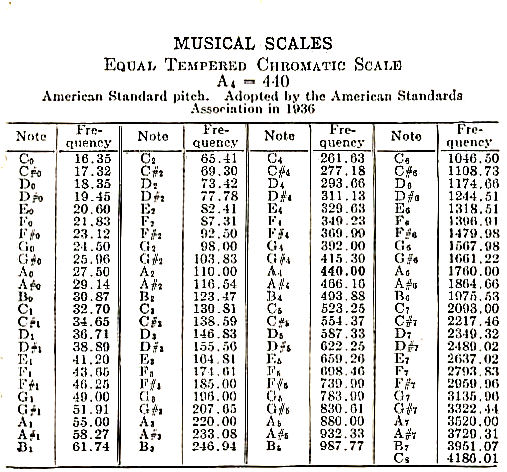
I have watched tympani (kettle drum) players tune their drums prior to an orchestral performance. I have always prided myself on being able to tell when an instrument such as a banjo or guitar is in tune. However, tapping on a drum head simply sounds like "thoink" to me no matter what it is tuned to. I assume that experience over time allows one to learn to identify drum notes. Since I don't know any tympani players that might be willing to teach me how to listen, I decided to use a Fourier spectral analysis tool. It worked quite well - after I realized that the fundamental frequency is the first peak but not necessarily the loudest peak. The Fourier tool I used assumes the loudest peak must be the one it should report so the first chart below illustrates that. The first peak is at approximately 96 Hertz but the tool sees that the loudest peak is the fourth harmonic at 397 Hertz so reports that. By using the cursor though, you can get a read-out of the true fundamental resonant frequency..
The following preliminary tests were done using the stock 1976 Gibson Mastertone RB-250 that I have been playing since 1976.
Case 1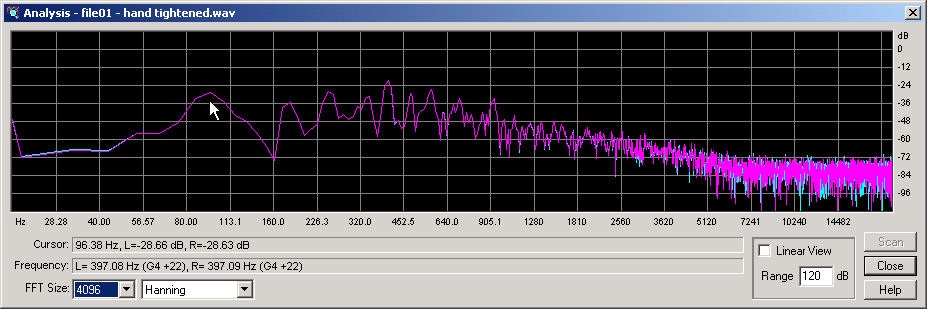 Listen to the drum head being tapped. Banjo head with hand-tightened nuts. Head is pretty loose. The bridge was removed for this case. So the drum head is free to vibrate with no constraints. In the above spectrogram plot, the horizontal axis shows the frequency and the vertical axis shows the loudness in dB. The "Cursor" field shows the frequency at the position of the cursor and the loudness in dB for the left and right channels. (We used only one channel so both are closely matched...) The spectrogram shows that the fundamental resonant frequency is approximately 96.38 Hertz. The cursor marks this frequency. The loudest output however is at the forth harmonic whose frequency is being shown as 397.08 Hertz. We are interested however in the fundamental frequency because that is what the drum head is currently "tuned to". In this case, the banjo head is tuned to approximately G2. Banjo strings in a normal G-tuning from fifth string to first string are G4, D3, G3, B3, D4, or 392, 147, 196, 246, 311 Hertz respectively. |
Case 2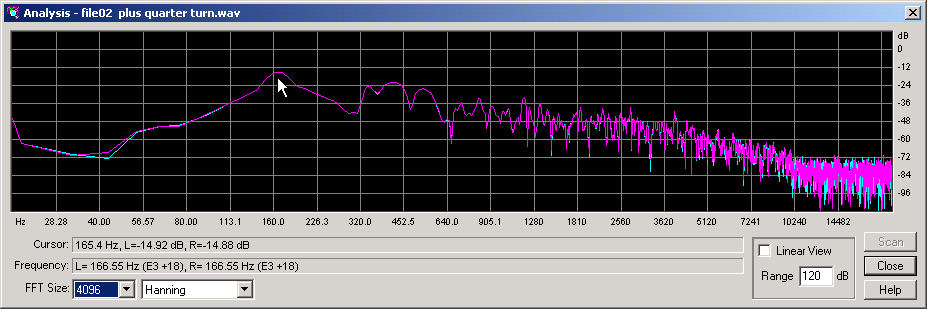 Listen to the drum head being tapped. Bridge is still removed. Tightened each nut 1/4 turn from the previous case. The resonant frequency is now approximately 166.55 Hertz or an E3. We came up 9 half-steps from the previous case! |
Case 3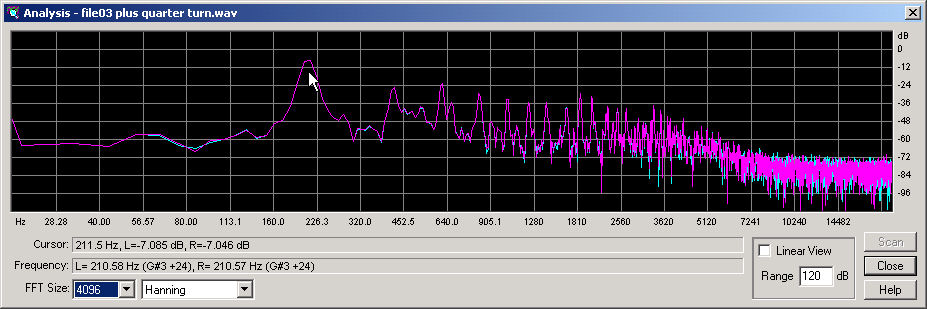 Listen to the drum head being tapped. Bridge is still removed. Tightened each nut an additional 1/4 turn. The resonant frequency is now approximately 210.58 Hertz or a G#3. We came up only 4 half-steps from the previous case. |
CASE 4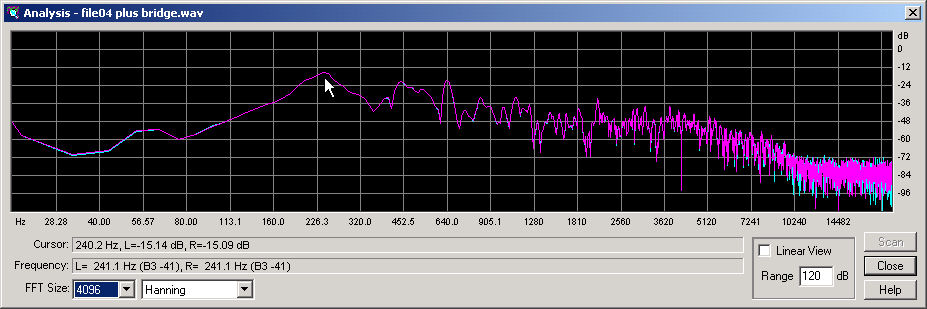 Listen to the drum head being tapped. No additional tightening of the drum head. Bridge was placed onto the head and the banjo was tuned to standard G tuning. Strings were damped for the tap-testing. The resonant frequency is now approximately 241.1 Hertz or approximately a B3. The pressure of the bridge has caused the resonant frequency of the banjo head to increase by 3 half-steps. The magnitude of the change is somewhat surprising. With the strings taut, the bridge is putting significant pressure on the banjo head. |
CASE 5
|
CASE 6
|
CASE 7
|
CASE 8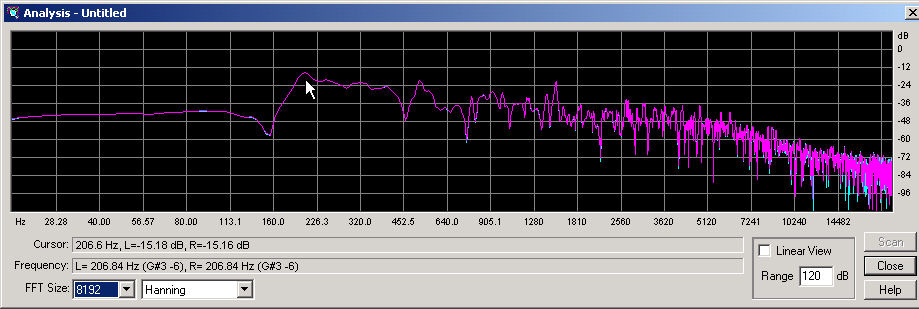 Listen
to the drum head being tapped. Listen
to the drum head being tapped.Drum head retuned iteratively until it reached G#3. Strings were damped for the tap-testing. The resonant frequency is now approximately 206.84 Hertz or approximately a G#3. There is something interesting about this frequency. The decline in amplitude at higher frequencies as shown in the above spectrum seems to be less than for other head tunings. This could result in more volume across the entire range of the instrument. |
So far, I still do not have an answer to what the optimum frequency of the drum head should be.
The article by Rossing and Rae indicates that G# is the "...head tuning preferred by many banjo setup specialists...". If we look at the spectrum shown in case 3, where the head is approximately set at G#3, we see that the curve at the resonant frequency (the first peak) is high and narrow indicating that something special is indeed occuring at this frequency. The harmonics are also sharp peaks. Rossing and Rae say that the "...vibrational modes are very discrete" at the G#3 tuning. I think this might be what they meant.
However, note that case 3 does not yet have the bridge in place.
In case 8, I retuned the head until it is now resonate at G#3 with the bridge in place.
I am going to leave the banjo set up this way and see if I like it.
I might still prefer the sound I get when the drum head is very close to the elastic limit. It sounds less "muddy" to me, i.e., the banjo notes appear to be clear with less "noise". Again subjective and I don't see any clear way to express it. The answer should be in the spectral data or wave files above if we can make sense of the data.
New Tone Ring 22 Jan 04 - Huber Tone Ring - Nickel
I ordered a "Huber Flathead Tone Ring--NKL" from Janet Davis Music Company on 15 November 04 via the internet. I received the Tone Ring on 20 Jan 05, slightly longer than the sentence on the Invoice which reads "Your invoice appears below. Please allow approximately 7 -10 business days to receive it."On Saturday, 22 Jan 05, I found time to take my banjo apart and see if I could install the Huber Tone Ring. The first question of course is whether the new ring would fit on the existing wooden rim. I bought my Banjo new in 1976. It is a Gibson Mastertone with serial number 00201742 for reference. (The serial numbers provide clues regarding manufacturing styles and components in use at particular times. I've been told that this banjo was made after Gibson improved their workmanship that had reportedly suffered somewhat in the few preceding years... I have always been happy with this banjo. Stays in tune extremely well. Sounds good as delivered. But - I have heard banjo's that sounded a little better so I was curious to see if I could effect any improvement.)
Up-front answer to eliminate suspense: The improvement was DRAMATIC in my opinion! Super wonderful! Huber is my hero! Thanks Steve!
This image below shows the original tone ring on the rim. Note the arrow showing the outside of the rim and the tone-ring. The arrow is pointing to the place where the two come together. Although there appears to be a dark line there, the fit was essentially perfect (according to some sources). Right down against the wood...
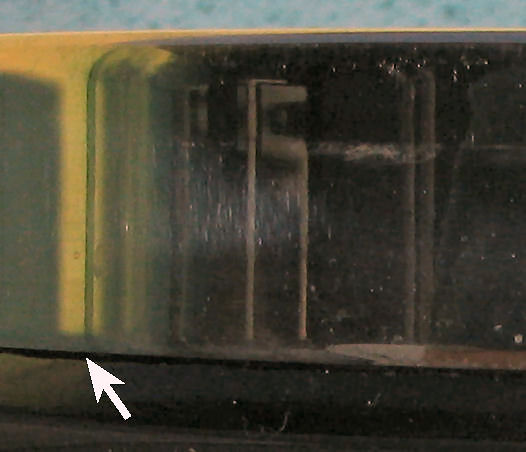

This image shows the rim with the old tone ring removed. The arrow is pointing to a compression groove made by the inside of the old tone ring. The old tone ring was not overly tight but it could not be slid sideways. The groove was apparently caused by the inner circle of the old ring pressing on the wood due to the tension on the drum head. That also, over time, caused the outer circle (sometimes called the "skirt") of the old ring to fit tightly up against the wooden ring-like structure seen on the outside of the rim in the image above.
So the question was whether the Huber tone ring would fit without a lot of work... Answer is that it slipped on with no difficulty. Conventional wisdom says that the ring should be tight but not too tight. In fact, the book "Complete Banjo Repair" says: "A good test is to see whether you can mount the ring by hand. If you have a good hard job of it, the ring fits well. If you have so hard a job of it that you must use a tool to hammer or press, then the ring is too tight; if the job is effortless, the ring is too loose. For plain ordinary good sound, a good fit is probably more important than any variation in design." So I was a little worried since the Huber ring is "too loose" on my stock rim. On my rim, the Huber ring can be slid from side to side slightly indicating that the fit is not at all tight. Probably 1/32 of an inch.
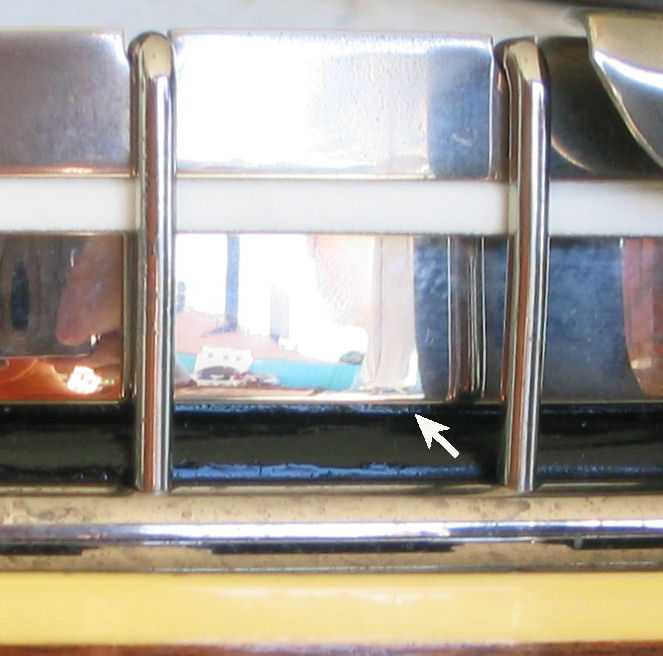
This image shows the ring in place with everything set up. The arrow is pointing to the boundary between the outer circle (skirt) of the Huber ring and the outer area of the rim. There is 1/32 of an inch gap between the metal and the wood. The old ring sat on the wooden lip and there was no gap.

This shows a cross-section of the rim and tone ring. The inner circle of the rim sits on the inner circle of the rim. The inner circle of the Huber rim is wider than that of the original tone ring so the Huber ring sits on the wood that has not been compressed by the old ring. There is also a tiny bit of space between sides of the rim and the new tone ring's skirt. Note that the above drawings are not to scale. They were done to help give some idea of the two configurations.
The results I obtained were rather astounding to my ear... Much brighter. Much better sustain all the way up and down the neck. Significantly louder.
I am now inclined to doubt the "conventional wisdom" saying that the skirt should fit tight. I am now inclined to think that it should have a gap as shown above so that it can ring. (It should be noted that there is one place that the ring will touch the rim - there is a bolt that goes through it to attach the neck to the control rods. The entire rest of the skirt however is free to ring...)
The following table shows the frequency spectrum of the old ring when it is suspended on a nail and tapped followed by the frequency spectrum of the new ring using the same technique, followed by the frequency spectrums of various tensions during tightening of the head. I finally stopped tightening when the head, when tapped, showed the fundamental resonant frequency to be approximately A3.
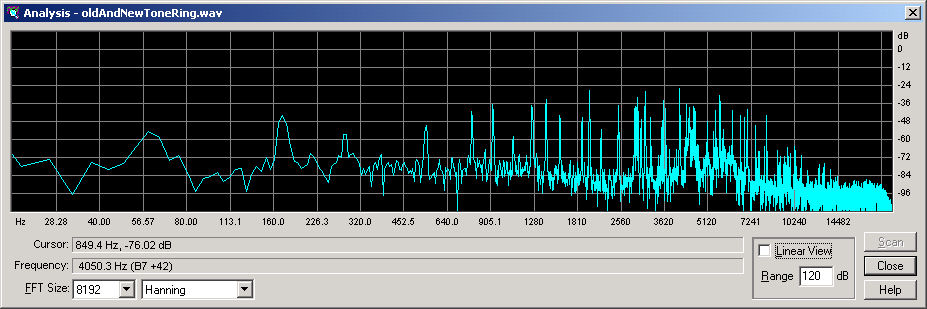 Listen to the old tone ring being tapped. Fundamental frequency (first peak above) is about 58 Hz or A#1. |
 Listen to the new Huber Tone Ring being tapped. Fundamental frequency (first peak above) is still about 58 Hz or A#1. |
 Listen to the drum head being tapped. Fundamental frequency (first peak above) is about 157 Hz or approximately D#2. |
 Listen to the drum head being tapped. Fundamental frequency (first peak above) is 196.57 Hz or approximately G3. |
 Listen to the drum head being tapped. Fundamental frequency (first peak above) is 185.39 Hz or approximately F#3. |
 Listen to the drum head being tapped. Fundamental frequency (first peak above) is about 196.32 Hz or approximately G3. |
 Listen to the drum head being tapped. Fundamental frequency (first peak above) is about 207.71 Hz or approximately G#3. |
 Listen to the drum head being tapped. Fundamental frequency (first peak above) is about 213.24 Hz or approximately G#3. |
 Listen to the drum head being tapped. Fundamental frequency (first peak above) is about 217.43 Hz or approximately A3. This is where I left it. Sounds great set here. |
Copyright 1997 - 2005 Howard C. Anderson


